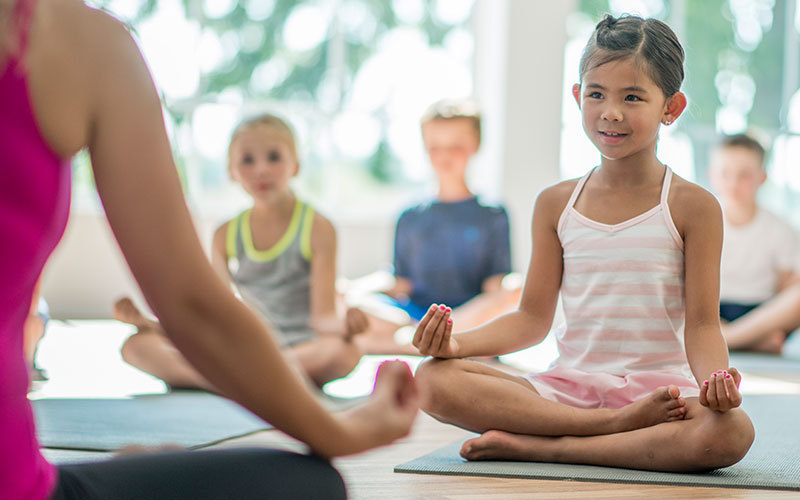Yoga has been gaining popularity in the K-12 school setting, particularly over the past decade. In fact, Harvard Health reports that 1.7 million U.S. children did yoga in 2012 — an increase of 400,000 from 2007. As more and more research points to evidence that yoga can improve academic achievement, positive behavior, and overall well-being, a growing number of teachers are choosing to integrate the practice into their lesson plans.
Incorporating yoga in the classroom gives students “the tools to calm themselves during anxious moments, quiet their little minds of the negative thinking, and feel good about themselves in general,” according to Yoga Kids. Through exercises such as breathing techniques, meditation, and mindfulness, the principles of yoga can become a valuable part of your students’ school day.
Benefits of School Yoga
Both yoga and mindfulness have been shown to improve mental and physical health in children 6 to 12 years of age, Harvard Health says. They can improve students’ balance, endurance, and strength, as well as focus, memory, self-esteem, and anxiety. All of these elements play an important role in classroom behavior and academic performance.
Here are some of the other ways yoga in the classroom can benefit students.
Control and Confidence
Yoga can help students develop self-control and respect for their bodies as they grow and change. It can also help students feel strong and comfortable in their own skin.
Mind-Body Awareness
When students understand the connection between their mental state and physical well-being, they can identify healthy ways to cope with stress and negative emotions.
Focus
When students are tasked with holding a specific yoga pose or completing various mindfulness activities, they learn to improve their ability to focus. This is particularly important for students with ADHD and other attention challenges.
It is important to note that yoga in the classroom can have real benefits for teachers as well. “Recent research suggests that providing educators with training in yoga- and mindfulness-based skills may have several beneficial effects for educators, including increases in calmness, mindfulness, well-being, and positive mood,” among other benefits such as decreasing stress and emotional reactivity, Yoga 4 Classrooms explains.
Adding Yoga to the Classroom Day
Here are some helpful tips for adding yoga and mindfulness to your classroom:
Start with Yoga Breaks
During transition times, have students take a 10-minute break to do breathing exercises or complete a few pose sequences. Yoga Kids recommends these breaks after lunch, before a test, or to start the school day.
Focus on Breathing
Teaching students to do deep breathing exercises is an easy way to create an environment of focused calm. Have students take a deep breath, then hold it for a count of three. Then have them breathe out as if they’re blowing out a candle, and repeat this cycle five times, Harvard Health suggests.
Use Visualization Techniques
Guided visualization is an easy way to let your students use their imagination while increasing mindfulness. Dana Santas, a yoga trainer for professional athletes, suggests having children choose a destination to visualize in their mind, then asking them to imagine what they see, smell, and hear.
Keep your students’ ages and attention spans in mind when beginning yoga practice. It’s a good idea to keep poses and games short, especially in the beginning. Work on providing structure while keeping a playful mindset for younger students. You can also focus on easier poses that are less likely to cause injury.
Above all, it’s important to make yoga fun for your students. Play games that incorporate yoga poses or have students practice with a partner as a way to have fun while learning to work with others. All of these are great ways to make classroom yoga a part of your routine.







